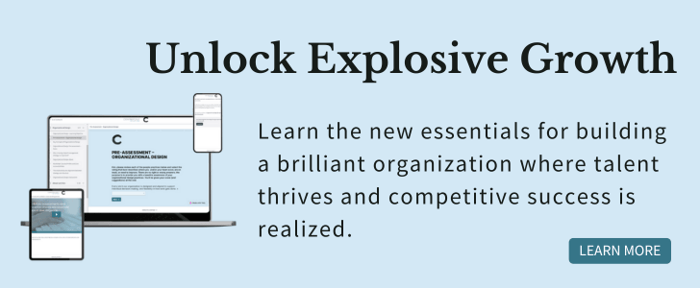Early stage" or “next generation” companies aren’t just rewriting the rulebook, they’re turning it upside down. Whether in the tech sector or elsewhere, it’s clear they’ve challenged traditional paradigms of how a company should operate. This is evident on many levels, specifically with talent management and how they succeed in leading the innovation agenda.
In recent conversations with several leaders of these companies, it’s apparent that they operate on the assumption that their competitive advantage is transitory – always to be challenged – and their only real sustainable competitive advantage is their culture, and specifically, the innovation philosophy within.
The very word innovation may sound buzzy these days, and it can be cliché, yet it’s a driver of the sustainable competitive advantage every business seeks. So what does it really mean? It can be defined as creating novel solutions to everyday problems. Or combining ideas to invent a unique solution. It’s not necessarily about finding new ideas, rather it’s about challenging old assumptions and re-anchoring to meet new realities. Consider some of the bigger players who do this: Nvidia, Amazon, Uber.
Here then are four dimensions of the early-stage cultures that can be applied to any business, no matter the size and industry:
1. Being intentional about the grander purpose.
Beyond enhancing shareholder value, what’s your firm’s innovation intent? Have you described the grander purpose of the difference you’ll make to your customers and the communities you serve? Your purpose should get people excited about the strategic direction you’re taking. If you’re developing new products or markets, parallel initiatives need to happen internally to support that – from finance to customer service and your overall talent practices. What makes early-stage companies unique in this way is their often simultaneous mission to be both people and profit driven; as they articulate the business vision, so too is the talent agenda they want to achieve. How might a grander purpose inspire your team’s next innovation?
2. Innovation can be considered and incremental.
Innovation is most often about refining ideas over time and allowing the voices to be heard that want to challenge old assumptions of how things have always been done. Make continuous improvement a part of your culture, and reward ideas that create efficiency or make pragmatic changes for the better. Allow time for post-project debriefs, consider the lessons learned, and celebrate wins and even fails when there’s advancement made because of them. Game-changing developments can be exciting and essential, but often small tweaks to existing products or policies can make the difference over the long term. What small but powerful change could you start with today?
3. Leveraging Feedback Loops for Continuous Innovation
In early-stage companies, feedback isn’t just a box to check; it's a foundational tool for continuous improvement. By establishing real-time feedback loops with both employees and customers, these companies stay responsive to changing needs and emerging ideas. Here are some tips for making the most of these feedback loops:
- For instance, employee feedback is often gathered through regular, informal check-ins rather than annual reviews, allowing leaders to address concerns, remove obstacles, and implement new ideas quickly.
- Similarly, customer feedback can be systematically integrated into product development through surveys, usability testing, and direct customer interactions.
- These real-time feedback mechanisms foster a culture of adaptability. When feedback is consistently reviewed and acted upon, employees see that their voices matter, which encourages them to share insights proactively.
- As a result, companies can identify and correct issues early, fine-tune products, and pivot strategies to keep pace with market changes.
In these ways, feedback loops become a driver of incremental innovation, enabling organizations to align closely with both their talent and customer base. What feedback loops need to be strengthened in your organization?
4. Cross-Functional Collaboration Drives Innovation.
Cross-functional collaboration is a pillar of innovation for early-stage companies. By bringing together diverse teams—such as engineers, marketers, product developers, and customer service representatives—these companies can spark ideas that wouldn’t emerge within siloed departments. Collaboration across functions allows teams to approach problems from different perspectives, combining technical insights with user-focused thinking to create solutions that are both feasible and impactful. Here are two highlights:
- Early-stage companies often encourage team members to work on cross-functional projects or “innovation pods” that tackle specific challenges. These pods can harness the strengths of each team, allowing marketers to share customer insights, engineers to propose viable solutions, and designers to enhance the user experience.
- Additionally, regular cross-departmental brainstorming sessions provide a structured setting to identify and address obstacles, generating holistic solutions.
This level of collaboration not only drives innovation but also strengthens the company’s overall agility, as diverse teams can quickly come together to solve problems and capitalize on new opportunities. By fostering a collaborative environment, early-stage companies eliminate the typical barriers we see across departments, allowing fresh ideas to flourish, leading to a more cohesive approach to innovation. Are cross-functional barriers keeping your team's great ideas under wraps?
Who is the most creative person you know? Not yourself? We all have the power to be creative and expand our capabilities for broader thinking and analysis. If new or refreshed ideas aren’t bubbling up in the daily work experience, here are some approaches that can change the game:
- It may be time to consider ways to welcome ideas from anyone: your junior admin person, your interns, or those who stand at the back wall in town hall meetings. Holding ‘Dream Big’ days or sessions can help switch things up and give people the space they need for undistracted thinking. If everyone around you is operating at over-capacity and running from meeting to meeting, creativity just won’t happen.
- Consider also the messaging spoken and heard in the flow of daily conversation, and especially those at the water cooler. Are you or others stiflers (“this won’t work because...”), or motivators (“how might this work?”). Change-averse communication will stop inspiration in its tracks.
- It’s important then to give innovation the support it needs by allowing individuals to rotate out of various work or project teams, to hire for curiosity by asking candidates how they’ve solved problems at work, and to encourage individuals to reach out to those outside their usual network for ideas and support.
- Even 20 minutes set aside in a monthly management meeting can be valuable to raise new ideas or ask what problems are standing in the way of maximizing customer satisfaction or meeting your competition head on.
Above all, the innovation cultures of these companies are characterized by flexible, agile and contemporary people practices that by their nature address individual needs better than a one-size-fits-all approach. More frequent performance check-ins for example, allow for timely examples of progress toward both business and professional goals and are reflective of and aligned with the more rapid product development cycles typical of these new companies.
Even if your company isn’t a darling of the tech sector or anywhere near it, it can still transform itself by adopting practices based on the innovation blueprint. Prioritizing a focus on the role of talent is key. If there’s one thing to take away, it’s this: true innovation begins with the people who dare to question the usual, no matter their position. What’s your next bold move to foster a culture of creativity and continuous improvement?"
If you're looking to refresh or redesign your people and culture strategy to better align with your innovation agenda, consider the Align. Grow. Prosper. learning experience. This course can help you achieve your objectives more efficiently and effectively than ever before.





